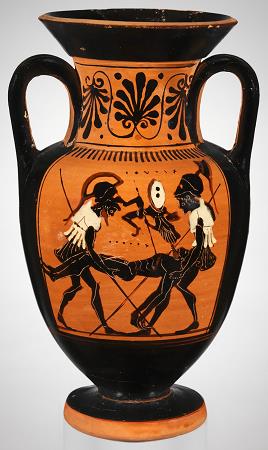
Diosphos Painter. The Diosphos Painter was an Attic vase painter of the black-figure style who was active in Athens about 500 to 470/60 bce.
He was a successor to the Edinburgh painter and the workshop of the Sappho painter. He did not work with the red-figure technique dominant in his time, but with the black-figure and above all with white-ground technique.
He mainly decorated small lekyths. Among his better works are alabastra and small neck amphoras.
Compared to other artists of his time and style such as the Sappho painter, he is an artist of lessor quality. His artistic repertoire is also rather modest.
His lively figures usually have quite large heads and appear quite lean. Despite this, he can show powerful images on some lekyths. As time went on, the lekyths that the Diosphos painter adorned became increasingly slender. Sometimes he showed figures between large palmettes and parts of his figures can also be shown in outline drawings with the body painted as a silhouette, with the hair and clothes as outline drawings. In this half-outline technique he was influenced by red-figure painters at the same time, especially the Athena painter. Possibly he invented the decoration with two recessed stripes in the lower black-covered part of the vessel body of lekyths, which are often found in works by the Haimon painter.
He was a successor to the Edinburgh painter and the workshop of the Sappho painter. He did not work with the red-figure technique dominant in his time, but with the black-figure and above all with white-ground technique.
He mainly decorated small lekyths. Among his better works are alabastra and small neck amphoras.
Compared to other artists of his time and style such as the Sappho painter, he is an artist of lessor quality. His artistic repertoire is also rather modest.
His lively figures usually have quite large heads and appear quite lean. Despite this, he can show powerful images on some lekyths. As time went on, the lekyths that the Diosphos painter adorned became increasingly slender. Sometimes he showed figures between large palmettes and parts of his figures can also be shown in outline drawings with the body painted as a silhouette, with the hair and clothes as outline drawings. In this half-outline technique he was influenced by red-figure painters at the same time, especially the Athena painter. Possibly he invented the decoration with two recessed stripes in the lower black-covered part of the vessel body of lekyths, which are often found in works by the Haimon painter.
Wikipedia ...